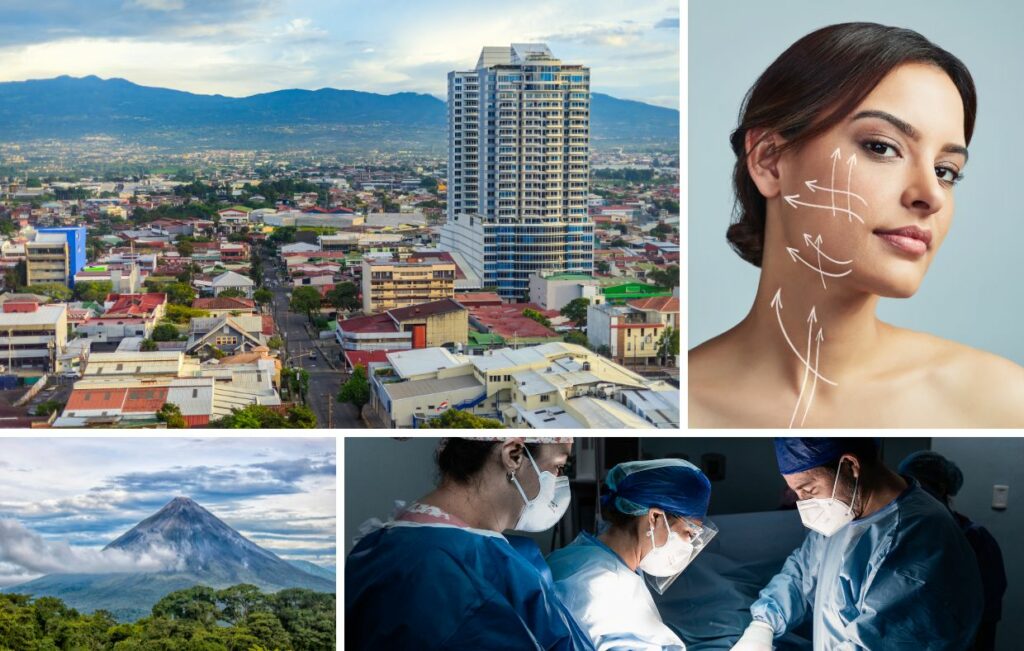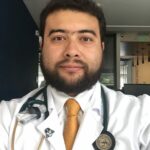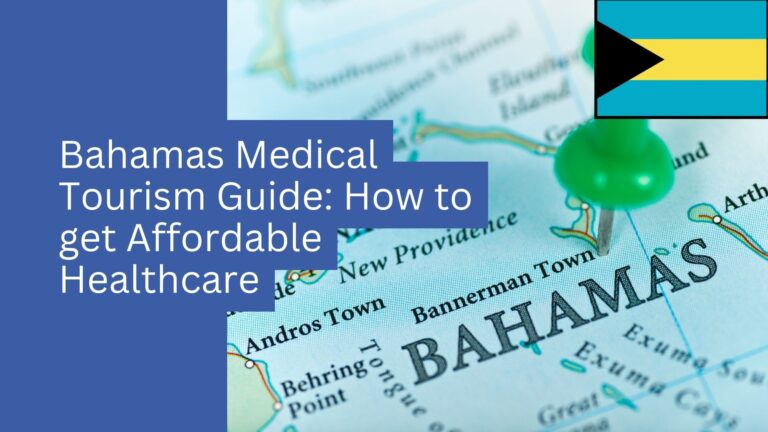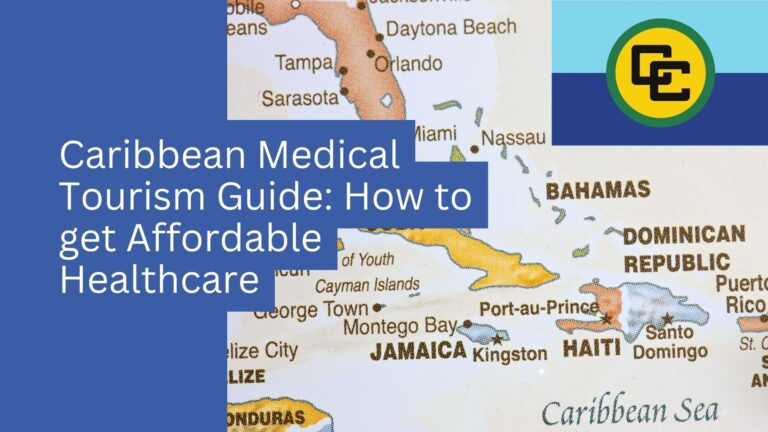Book Appointment Now

Facelift in Costa Rica: Complete Guide to Costs, Safety, and Recovery for Medical Tourists
Costa Rica has become a leading destination for North American medical tourists seeking facelift surgery. The country offers savings of 50-70% compared to U.S. and Canadian prices. But cost is only part of the equation.
This guide addresses the critical questions you need answered before booking facelift surgery abroad. You’ll learn about pricing structures, surgeon credentials, recovery timelines, and important considerations. We cover both the advantages and trade-offs of medical tourism.
The financial savings are real and validated. So are the considerations. This guide provides the factual information you need to make an informed decision about whether a facelift in Costa Rica is right for you.
What is a Facelift (Rhytidectomy)?
A facelift (rhytidectomy) is a surgical procedure that tightens sagging skin, reduces wrinkles, and restores a more youthful facial contour by repositioning underlying tissues and removing excess skin.
The surgery targets the lower face, jawline, and neck. It does not stop the aging process but turns back the clock on existing age-related changes. Results typically last 7-10 years, though individual outcomes vary. Learn more about our facelift services.
Why Do North American Patients Choose Costa Rica for Facelifts?
North American patients choose Costa Rica primarily for cost savings of 50-70%, combined with high-quality care when properly vetted:
- Significant cost savings – $7,500-$8,800 vs. $18,000-$25,000 in major U.S. metros
- High quality at elite tier – Rigorous safety and quality standards when properly vetted
- Superior recovery infrastructure – Specialized nurse-staffed surgical retreats unique to Costa Rica
- High English fluency – Language is rarely an issue in the private medical sector
- Relative proximity – 3-5 hour flights from major North American cities
Costa Rica balances high standards with accessibility for first-time medical tourists. The “very Americanized” private healthcare system creates a “low-friction” environment for North American patients. Read our complete guide for American medical tourists in Costa Rica.
How Much Does a Facelift Cost in Costa Rica vs. North America?
The cost difference between Costa Rica and North America is substantial and verified. Here’s how pricing breaks down across locations:
| Location | Cost Range | What’s Included | Notes |
|---|---|---|---|
| Costa Rica Private Clinic | $7,500-$8,800 | All-inclusive package | Set pricing, includes all fees |
| Costa Rica JCI Hospital | ~$14,000 | Surgery components | A la carte billing model |
| United States | $12,000-$25,000 | Varies by location | Typically unbundled fees |
| Canada | $10,000-$20,000 | All-inclusive | Major metro average |
The American Society of Plastic Surgeons reports an average surgeon’s fee of $11,395 for facelifts in the United States. This figure is misleading. It excludes anesthesia, operating room facilities, and other essential expenses. When you add these costs, the realistic all-in U.S. average ranges from $12,000 to $25,000.
Geographic location dramatically affects U.S. pricing. Los Angeles all-inclusive costs run $7,000-$15,000. New York City prices reach $20,000-$80,000. Major metro averages cluster around $18,000-$25,000 or more.
Canada’s pricing is comparable to the higher end of the U.S. market. All-inclusive costs typically range from $10,000-$20,000. Major metro averages sit at $15,000-$20,000.
The 50-70% savings claim is accurate when comparing all-inclusive Costa Rican packages to unbundled North American pricing. A private clinic package at $7,500-$8,800 represents 60-70% savings versus a $18,000-$25,000 U.S. procedure. Even Costa Rica’s internationally accredited hospital pricing at ~$14,000 delivers 30-45% savings.
Your actual savings depend on facility choice. The $6,000 difference between a Costa Rican private clinic and JCI hospital is significant. This distinction matters when calculating your total budget.
What is the Difference Between JCI-Accredited Hospitals and Private Clinics?
The key difference is accreditation and pricing: JCI hospitals charge ~$14,000 while private clinics charge $7,500-$8,800—a 40% cost difference.

JCI (Joint Commission International) is the globally recognized benchmark for patient safety and healthcare quality. Costa Rica has two JCI-accredited facilities in San José that use an a la carte billing model (~$1,000/hour for operating room usage).
Private clinics may meet the same standards but without formal JCI certification overhead. They use all-inclusive package pricing and can deliver equivalent surgical outcomes for 40% less.
Your choice depends on priorities: If international accreditation provides peace of mind worth $5,000-$6,000, choose a JCI hospital. If you prioritize cost savings and are comfortable with a well-credentialed surgeon at a private clinic, that route offers substantial savings without compromising outcomes.
What Types of Facelift Procedures Are Available in Costa Rica?
Costa Rican surgeons offer the full range of facelift techniques:
- Standard facelift (traditional rhytidectomy) – Addresses lower face, jowls, and neck
- Deep plane facelift – Advanced technique repositioning the SMAS layer for more dramatic, longer-lasting results
- Mini facelift – Less extensive option for early aging signs with shorter incisions and faster recovery
- Neck lift – Commonly packaged with facelifts to address sagging neck skin and platysmal bands
- Blepharoplasty (eyelid surgery) – Frequently bundled with facelifts to address aging around the eyes
Bundled procedures save money on shared facility and anesthesia fees but increase recovery time and medical risk. We address this trade-off in the bundling section below.
What Credentials Should Your Costa Rican Plastic Surgeon Have?
Verifying surgeon credentials is your most important due diligence task. Look for these credentials and qualifications when evaluating potential surgeons:
| Credential | What It Means | Priority Level |
|---|---|---|
| ACCPRE Certification | Costa Rica Association of Plastic, Reconstructive and Aesthetic Surgery certification. National board certification standard. | MANDATORY – Immediately disqualify any surgeon without this |
| ASPS Membership | American Society of Plastic Surgeons membership. Signals surgeon has met rigorous U.S. training and ethical standards. | Highly Recommended – Provides powerful third-party validation for North American patients |
| JCI Hospital Affiliation | Operates at Joint Commission International accredited facilities in San José/Escazú. | Highly Recommended – Demonstrates commitment to highest international standards |
| Academic/Leadership Positions | University professorships or leadership roles in ACCPRE. | Recommended – Indicates peer recognition and professional standing |
| High Procedure Volume | Performs 20+ rhytidectomies per month. | Essential to Verify – Distinguishes specialists from generalists |
Patient volume data is not publicly available. Surgeon caseload information is not available through public databases. Patient volume statistics do not exist at the provider level. Even ISAPS (International Society of Aesthetic Plastic Surgery) reports only aggregate national-level data.
This information must be obtained directly during consultations. The key question to ask: “How many rhytidectomies do you perform per month?” This reveals whether you’re working with an experienced specialist or a generalist who occasionally performs facelifts.
Medical Tourism Packages simplifies this verification process by connecting you with thoroughly vetted surgeons who meet these credential requirements.
Where Should You Have Your Facelift in Costa Rica?
San José and Escazú are the only locations for top-tier facelift surgery in Costa Rica.
The Central Valley metropolitan area contains all elite surgical talent, both JCI-accredited hospitals, and specialized recovery infrastructure. Guanacaste is Costa Rica’s premier tourist destination but not a medical hub. Top surgeons based in San José travel to Guanacaste only once monthly for procedures.
For top-tier results, you need San José/Escazú access to:
- JCI-accredited hospital facilities
- Surgeons with full-time, established practices
- Specialized recovery inns with 24/7 nursing care
- Immediate surgeon access for post-operative visits
The beach recovery fantasy does not align with medical reality—serious medical tourism happens in San José, not Guanacaste.
How Long Does Facelift Surgery and Recovery Take in Costa Rica?
Plan for a mandatory 10-14 day stay in Costa Rica for facelift surgery and recovery.
| Timeframe | What Happens | Location |
|---|---|---|
| Day 0 | Surgery (3-6 hours) | Clinic/Hospital |
| Days 1-2 | Initial monitoring for complications | Clinic/Hospital (1-2 nights) |
| Days 2-3 | Discharge, possible drain removal | Transfer to recovery inn |
| Days 3-7 | Primary recovery phase, surgeon visits | Recovery inn |
| Days 7-10 | Suture removal | Surgeon’s office |
| Days 10-14 | Final check-ups, swelling subsides | Recovery inn/office |
| Days 14-15 | Medical clearance to fly | Final evaluation |
This mandatory stay allows your surgeon to manage the most common complications—hematoma and infection—before you fly. Flying too early poses health risks from cabin pressure changes affecting healing tissues and immobility increasing thrombosis risk.
Combination procedures require longer stays. Bundling a facelift with major procedures (tummy tuck, breast reduction) requires a 21-day minimum stay and carries exponentially increased risk of complications like DVT and infection.
What Makes Costa Rica’s Recovery Infrastructure Unique?
Costa Rica offers specialized, nurse-staffed surgical retreats purpose-built for post-operative care—not standard hotels where most medical tourists recover.
These facilities provide 24/7 professional oversight, removing logistical burdens so you can focus on healing:
- Three healthy meals daily prepared for post-surgical patients
- Transportation to all surgeon appointments
- Medication assistance and schedule management
- 24/7 nursing care with immediate response to concerns
- Surgeon visits directly to the facility
- All-inclusive pricing at $100-150/day ($1,400-$2,100 for 14 days)
Seamless integration with surgical care: Your surgeon works closely with these facilities, often making follow-up visits directly to the inn and communicating with staff about your progress.
Cultural advantages: The “very Americanized” private healthcare system, high English fluency, and “low-friction” environment minimize culture shock for North American patients.
This model appeals to analytical, first-time, or solo medical tourists who prioritize professionally-managed recovery over budget accommodations. The 24/7 nursing care enables complication monitoring impossible in standard hotels.
How Does Costa Rica’s Climate Affect Facelift Recovery?
Costa Rica’s tropical heat and humidity create medical risks that require indoor, air-conditioned recovery.

Climate-related risks:
- High humidity makes surgical wounds difficult to keep dry, increasing infection risk
- Heat and humidity worsen post-operative swelling
- Compression garments become uncomfortable in heat, affecting compliance
- Sun exposure causes permanent darkening and hyperpigmentation of scars
You must remain indoors in a cool, air-conditioned environment—this is mandatory, not optional.
Seasonal timing matters medically. The dry season (December-April) offers optimal conditions. The rainy season (May-November) has higher humidity, making it the medically riskier season despite lower package prices. Risk-averse patients should choose the dry season.
Beach recovery is medically contraindicated. You will spend recovery indoors experiencing the tropics through air-conditioned windows.
What Results Can You Expect from a Facelift in Costa Rica?
Elite tier providers deliver high-quality outcomes when properly vetted. Swelling subsides gradually over days 10-14, with full results emerging over time as healing progresses.
Long-term results assessment is problematic. Provider photo galleries show immediate results but lack standardized long-term documentation (1+ years). This industry-wide transparency gap makes it impossible to assess facelift longevity using photo galleries alone—a transparency issue across medical tourism, not unique to Costa Rica.
What Are the Most Common Risks and Complications?
The most common complications are hematoma (blood collection requiring drainage) and infection, both manageable during the mandatory 10-14 day recovery stay with 24/7 nursing care and surgeon access.
Safety is provider-dependent, not destination-dependent. Elite tier providers have low complication rates and strong safety protocols. U.S.-based warnings about infections and unsanitary conditions apply to unvetted “bargain-basement” clinics, not thoroughly vetted, credentialed surgeons at accredited facilities. Safety is a choice you make during vetting.
Watch for these red flags when researching clinics and surgeons:
| Red Flag | Why It Matters |
|---|---|
| Pricing significantly below $4,000-$6,000 range | Suggests bargain-basement clinic with potentially compromised safety protocols |
| Poor English communication capability | Communication barriers increase medical risk and complicate informed consent |
| Unverifiable credentials or training background | Cannot confirm surgeon qualifications or experience level |
| Pressure tactics or unrealistic promises | Legitimate providers allow time for decision-making and set realistic expectations |
What Are the Travel Requirements for Costa Rica?
U.S. and Canadian citizens do not need a visa for stays up to 180 days—only a valid passport and return ticket.
Travel distance is 3-5 hours on direct flights from major North American cities, creating low post-operative DVT risk compared to distant destinations. English fluency is extremely high in Costa Rica’s private medical sector, creating a “low-friction” environment for North American patients.
How Should You Budget for a Facelift Trip to Costa Rica?
Understanding total all-in costs prevents budget surprises. The surgical fee is only one component of your total expense.
| Cost Component | Costa Rica Private Clinic | Costa Rica JCI Hospital | United States | Canada |
|---|---|---|---|---|
| Surgery | $7,500-$8,800 | ~$14,000 | $18,000-$25,000+ | $15,000-$20,000 |
| Recovery (14 days @ $100-150/day) | $1,400-$2,100 | $1,400-$2,100 | Home (no cost) | Home (no cost) |
| Airfare | Budget separately | Budget separately | N/A | N/A |
| Estimated Total | $8,900-$10,900+ | $15,400-$16,100+ | $18,000-$25,000+ | $15,000-$20,000 |
Airfare must be budgeted separately. Round-trip flights from major North American cities vary by season and booking timing.
Combination procedures add significant recovery costs. If you bundle multiple major procedures, you need a 21-day stay instead of the standard recovery period. This adds approximately $700-$1,050 in recovery accommodation costs ($100-150/day × 7 extra days).
Travel companions multiply costs. If you bring someone with you, budget for their airfare, lodging, and meals for the full required period. Many recovery inns charge per person for accommodations.
Should You Bundle Multiple Procedures?
Bundling procedures saves money on shared facility and anesthesia fees, but comes at a significant cost: exponentially increased medical risk and longer recovery.
Common combinations include facelift with neck lift, blepharoplasty, or “Mommy Makeover” procedures. However, major combinations require a 21-day minimum stay (vs. 14 days for facelift alone) and carry higher risk of serious complications including DVT and infection—risks that amplify when you’re far from your home support system.
The trade-off must be carefully evaluated: You save money but substantially increase medical risk, extend time away from work and family by a full week or more, and compound physical stress on your body.
When Should You Schedule Your Facelift in Costa Rica?
Seasonal timing has medical implications, not just price differences.
| Season | Months | Weather | Pricing | Medical Risk |
|---|---|---|---|---|
| Peak (Dry) | December-April | Pleasant, optimal recovery conditions | Higher travel and accommodation costs | Lower infection risk, safer recovery |
| Rainy (“Green”) | May-November | High humidity, frequent rain | Cheaper packages, fewer tourists | Higher infection risk, worse swelling |
As detailed in the climate section, Costa Rica’s tropical humidity directly impacts recovery. The dry season (December-April) offers optimal conditions, while the rainy season (May-November) presents elevated risks due to higher humidity.
Risk-averse patients should choose the dry season despite higher costs. The medical benefits justify the modest price premium. If cost is your absolute priority, the rainy season offers genuine savings—but understand you’re making a calculated trade-off between price and optimal recovery conditions.
What Should You Ask During Your Consultation?
Virtual consultations are standard for medical tourism. Ask these essential questions:
- How many rhytidectomies do you perform per month? (20+ indicates specialist; 2-3 indicates generalist)
- What are your credentials? (Verify ACCPRE, ASPS, training background)
- Where will my surgery be performed? (Accredited hospital or private clinic)
- What is included in the package price? (Itemize all fees)
- What is the recovery timeline for my specific procedure?
- What complications management protocol do you follow?
- What post-operative follow-up do you provide after I return home?
Quality surgeons will show you their facility and introduce you to the anesthesiologist before surgery.
What Should You Pack for Facelift Surgery?
Pack for medical recovery, not tourism—you’ll spend 14 days indoors in air conditioning.
Essentials:
- Current medications and prescriptions in original containers
- Medical records and documentation
- Loose, comfortable clothing and button-front shirts (avoid pulling garments over your head)
- Items for indoor entertainment (books, tablet, laptop)
- Comfortable slip-on shoes
- Personal toiletries
Confirm with your surgeon whether they provide compression garments or if you need to bring your own.
How Does Costa Rica Compare to Other Medical Tourism Destinations?
Costa Rica’s value proposition is balance: not the cheapest or closest, but offering the combination of relative proximity (3-5 hour flights), high-quality JCI-accredited options, superior English fluency, and specialized recovery infrastructure.
| Factor | Costa Rica | Mexico | Colombia | United States |
|---|---|---|---|---|
| Average Cost | $4,000-$6,000 | $4,000-$6,000 | $3,500-$5,000 | $12,000-$25,000 |
| Key Advantage | Recovery infrastructure | Proximity to border | Cosmetic expertise | Full legal protection |
| Flight Time | 3-5 hours | 1-4 hours | 4-6 hours | N/A |
| DVT Risk | Low | Lowest | Medium | None |
| Recovery Model | Specialized surgical retreats | Varies, often hotels | Varies, often hotels | Home recovery |
| English Fluency | Extremely high | High in clinics | Spanish dominant | Native |
The 3-5 hour flight creates low post-operative DVT risk compared to distant destinations requiring 10+ hour flights.
Frequently Asked Questions
Is a facelift in Costa Rica worth it?
Yes—if you properly vet providers and understand the trade-offs. Cost savings of 50–70% are real, elite-tier quality is available, and the recovery infrastructure is stronger than most medical tourism destinations.
Are Costa Rican plastic surgeons qualified?
Yes—when properly vetted. ACCPRE certification is mandatory for legitimate plastic surgeons, and many also belong to the ASPS, signaling rigorous training and ethical standards. Top surgeons often hold academic or leadership roles. Always verify credentials directly; patient volume statistics are not publicly available.
Can you trust internationally accredited hospitals in Costa Rica?
Yes. JCI-accredited facilities meet global benchmarks for patient safety and quality, with high safety standards and low infection rates. Properly vetted private clinics can deliver equivalent outcomes at lower cost.
What is the biggest risk of getting a facelift in Costa Rica?
Choosing an unvetted surgeon or facility. Safety is provider-dependent, not destination-dependent. U.S. warnings about infections target bargain-basement clinics, not thoroughly vetted elite providers. Also consider that complications are harder to manage after you return home due to limited continuity of care.
What happens if something goes wrong during recovery?
The required 10–14 day recovery window is designed to catch and manage common issues (like hematoma or infection) before you fly home. Surgeons conduct follow-ups at recovery inns, and 24/7 nursing supports monitoring. Complications after you return are much harder to manage, which is why staying for the full recommended period is critical.
How do I choose between multiple surgeons?
Verify ACCPRE certification and prioritize ASPS membership. Ask about monthly rhytidectomy caseload—20+ per month suggests a specialist. Review training, academic roles, and photo galleries; evaluate communication during virtual consults; and confirm complication management protocols.
What red flags should I watch for when researching clinics?
Beware of prices far below market, poor communication, unverifiable credentials, refusal to provide detailed package breakdowns, pressure tactics, and unrealistic promises. Use a structured checklist to verify providers before booking.
Should I travel alone or bring a companion?
Solo travel is feasible—recovery inns provide 24/7 nursing and full support. A companion offers emotional support, but budget for airfare, lodging, and meals for the entire stay; many recovery inns charge per person.
What is the best time of year for facelift surgery in Costa Rica?
December–April (dry season) offers the best recovery conditions. May–November (rainy season) can be cheaper but the humidity increases risks; plan your stay accordingly.
Can I combine my facelift with a vacation?
No. Plan for indoor, air-conditioned recovery for the full 10–14 days. Heat, humidity, and sun exposure can jeopardize healing and darken scars. Tourism activities should wait until you are medically cleared to fly.
Is a Facelift in Costa Rica Right for You?
The decision requires weighing validated advantages against important considerations.
Key advantages of Costa Rica for facelift surgery:
- Significant validated cost savings
- High quality outcomes at elite tier
- Internationally accredited facilities available
- Unique specialized nurse-staffed recovery infrastructure
- Extremely high English fluency in medical sector
- 3-5 hour flight with low DVT risk
- All-inclusive pricing bundles all surgery components
Major risks and trade-offs:
- Different legal framework compared to domestic procedures
- Tropical climate increases infection risk
- Complication management challenging after returning home
- Required recovery period of 10-14 days (21 days for combination procedures)
- No systematic long-term results documentation (1+ years)
- Safety requires rigorous provider vetting
- Distance from home support system during recovery
The financial savings are real. So are the risks. Both must be weighed carefully.
How Should You Make Your Final Decision?
Your final decision should be based on a careful evaluation of financial savings against the inherent challenges of international medical tourism.
Significant cost savings are validated and real. However, these savings come with important trade-offs: distance from home during recovery, different healthcare systems, and the need for extended stays abroad.
Key factors to consider:
- Financial: Can you afford domestic surgery, or do the savings make this procedure accessible to you?
- Time: Can you commit to the required recovery period away from work and family?
- Risk tolerance: Are you comfortable being far from your home support system during recovery?
- Vetting effort: Are you willing to invest time in thorough surgeon and facility verification?
If you decide to proceed, commit to rigorous vetting. Verify ACCPRE certification. Confirm ASPS membership if available. Ensure accredited hospital affiliation. Ask direct questions about caseload and experience. Choose the dry season. Budget for the complete recovery period.
The decision is yours. Make it with full information about both the advantages and the risks.
What Are the Next Steps to Book Your Facelift in Costa Rica?
Medical tourism requires rigorous planning, credential verification, and logistical coordination. Medical Tourism Packages simplifies this complex process through comprehensive facilitation services.
Our facilitation services include:
- Surgeon credential verification and vetting
- Accredited hospital and facility confirmation
- Complete surgical package coordination
- Recovery accommodation arrangements
- Transportation and transfer coordination
- Ongoing support from initial consultation through post-operative care
We eliminate the complexity of international medical travel by managing every detail from consultation through recovery. Our team connects you with thoroughly vetted surgeons, coordinates all logistics, and provides support throughout your medical tourism journey.
Ready to explore your options? Contact Medical Tourism Packages for personalized consultation. We’ll help you make an informed decision with complete transparency about costs, credentials, and what to expect throughout the process.



